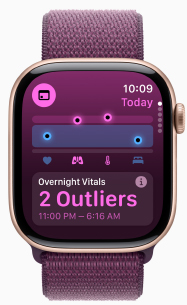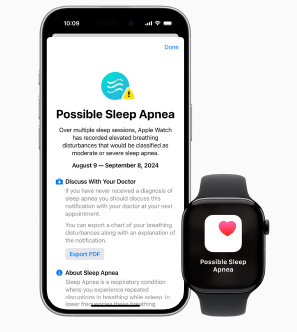APPLE WATCH SERIES 10
And APPLE HEALTH
Wellness at Your Wrist in the City That Never Sleeps
Given the health crisis I suffered in January, requiring lifesaving surgery, I needed to make sure that I was carefully monitoring my recovery as well as my overall health going forward. Of course, my first instinct was to rely on technology. As I had already used Apple Watch since its launch in 2015 (upgrading to various models over the years) and began to use Apple Health in the last few years, it made sense to see how things had evolved with the line recently. Enter Apple Watch Series 10, paired with the Apple Health ecosystem. This robust powerhouse has transformed from a mere fitness tracker and message alert indicator to an indispensable health companion, particularly resonating with a hard-charging New Yorker like me.


In other words, Apple Watch Series 10 is the evolutionary step bringing the line into one of the most powerful consumer-facing health tools on the market. It’s incredibly intuitive, proactively helping you manage your health journey.
A PERSONAL HEALTH REVOLUTION
Released in September 2024, Apple Watch Series 10 has marked a significant leap in wearable technology. Presented in a thinner design with the largest display to date, the device provides enhanced visibility and comfort. Beyond the stunning aesthetics, it introduces groundbreaking, incredible features like sleep apnea detection, utilizing advanced sensors to monitor breathing patterns during sleep—a condition affecting millions yet often undiagnosed.
Hardware is, as the GI Joe cartoons used to say, “only half the battle.” The Apple Health app on your iPhone pulls all the data from my watch and serves as a centralized hub for health data from various sources. It aggregates health data from various sources, including the watch, such as connected fitness equipment, third-party health apps, and even medical records. Want to monitor your walking steadiness? Need to know about your blood oxygen levels? Trying to figure out your medications and dosages? It’s all right there, presented in clean visuals and user-friendly dashboards that make sense of the complex science behind our bodies, and what it takes to care for them in 2025.
On the third-party hardware front, I started using a smart scale. I had lost over 40 pounds due to extreme sepsis. To have the second surgery (which I had just a few weeks ago), according to my surgeon, I needed to gain some of that weight back. But I had to make sure it was done in a healthy and responsible way. So, I used a smart scale which sent my weight, and BMI information into the Apple Health app. The interactive charts and trend analyses allowed me to track progress and make informed decisions about meals, protein and fat content to ensure I was gaining the right kind of weight. And, yes, I did cheat from time to time. I am human after all.
Throughout my recovery of the last three months, I had also needed to make sure I was understanding my many blood test results, tracking notes from my various doctors and more. Apple Health app seamlessly integrated all the data points from my MyMountSinai chart at Mount Sinai Hospital. As all my doctors use this system, I was able to find and manage all my information from one place in Apple Health. The side benefit to this is that my doctors have also been able to see some of the data coming from Apple Watch Series 10 to help me continue along a healthier path.
Throughout my recovery of the last three months, I had also needed to make sure I was understanding my many blood test results, tracking notes from my various doctors and more. Apple Health app seamlessly integrated all the data points from my MyMountSinai chart at Mount Sinai Hospital. As all my doctors use this system, I was able to find and manage all my information from one place in Apple Health. The side benefit to this is that my doctors have also been able to see some of the data coming from Apple Watch Series 10 to help me continue along a healthier path.
Moreover, the integration of the Vitals app on the Apple Watch Series 10 provides real-time insights into heart rate, respiratory rate, sleeping respiratory rate, and more, allowing me to stay attuned to what’s going on with my body throughout the day, and night.

Sleep apnea detection is perhaps one of the most impactful features yet. Using advanced sensors and machine learning, the watch can identify irregular breathing patterns during sleep — a silent condition that affects millions but often goes undiagnosed. When paired with the Apple Health app’s sleep tracking summaries and bedtime guidance, the Apple Watch Series 10 transforms from an accessory into a silent sentinel for long-term wellness. I suffered from sleep apnea prior to my surgery. As I quit smoking and lost all that weight, it has all but disappeared. There have been only a couple of nights my watch and Apple Health have reported anomalies which were attributed, by my doctor, to a head cold and eating too late one evening. But having the information and understanding everything has given me so much more confidence in my health journey.
LIFESTYLES OF THE TECH ENABLED
Of course, the Apple Watch Series 10 isn’t just about serious health monitoring—it also excels at motivating movement. With its iconic three-ring system for Move, Exercise, and Stand, the daily challenge to close your rings has become a digital-age wellness ritual. Add to that the robust fitness tracking for running, cycling, swimming, and strength training, and it becomes clear: this is not just a smartwatch—it’s a lifestyle companion.
As I had been severely limited in what exercises I was allowed to do, only being able to walk 100 yards at a time at one point, tracking my steps, exercise and how much I was standing became vital. Understanding how close I was to my goals each day helped me maintain some semblance of cardio activity while ensuring I was recovering responsibly. After all, I do tend to overdo it a bit when a challenge is in front of me. Apple Watch Series 10 helped me achieve balance and peace of mind.

LOOKING AHEAD: AI
AND PERSONALIZED HEALTH
It looks like the recently launched Apple Intelligence is about to play a larger role in the wellness space with the rumored launch of an AI-powered health coaching service. From what I am hearing from various tech-heads (of which I used to be one), the digital coach would reportedly use data from Apple Health to offer personalized recommendations on sleep, nutrition, movement, and mental health. For users who struggle to make sense of their metrics, this type of customized support could be a serious game-changer. In a city, a world, driven by data, it’s only fitting that personal health follows suit.
In the end, what makes Apple Watch Series 10 and Apple Health so distinctly valuable for New Yorkers is their subtlety. You don’t need to carve out extra time in your day to focus on your health—your wrist does the watching for you. It’s health without hassle, fitness without friction, and, perhaps most importantly, wellness without waiting.
In a city where the pace is relentless, schedules are stacked, and stress is literally poured with the concrete of everyday life – staying healthy requires more than just good intent. And in today’s ever-evolving world of nutrition, food trends or fads, and the waist-expanding summer deliciousness that is upon us, it’s even more important to be able to stay on top of your health.
The net net is that Apple Watch Series 10 and Apple Health have helped save my life. They keep me honest and make sure my doctors and wife are aware of what’s going on.





